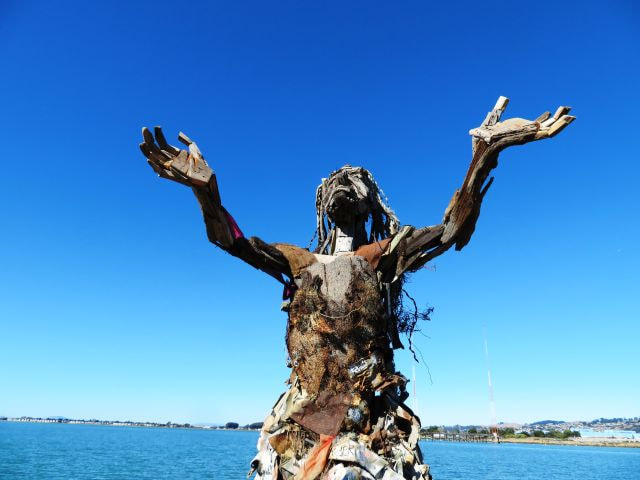|
Susan Moffat is not trying to preserve the art that has filled the Albany Bulb for many years. She is trying to preserve something more important – the spirit that put the art there. On Sunday, October 22, Susan led a Trail Trekker hike through the Bulb, which is owned by the City of Albany but is slated to be incorporated into the McLaughlin Eastshore State Park. The hike was revelatory, even to those hikers who thought they knew the Bulb well. It was built as a landfill for construction debris, gradually filling up from 1963 to 1983. For years Moffat, who teaches city planning at UC Berkeley, has been studying the “history of this artificial piece of land.” The 31-acre Bulb has been a popular spot for dog walkers, nature lovers, beach goers, and many others for years, and for decades was home to a thriving community of squatters until they were removed three years ago. Since then the park has been much changed, with much brush removed along with piles of dirt – and some art. But much art remains and, in the tradition of Albany Bulb art, it remains in constant flux. The goal of Susan’s group, Love the Bulb, which was founded a year ago and is a nonprofit, is to “make sure the creative spirit of the bulb continues,” she told the 30 people on the walk. “That’s what the bulb is about. It’s a very special place, kind of an adult adventure playground, where unlike most parks, you’re allowed to play around and alter things in ways that are usually not allowed (in parks).” Love the Bulb has been putting on creative public events at the Bulb – people creating sculpture to musical accompaniment, educational talks and walks, native plantings. Upcoming events include “a fun strolling concert” on November 5 featuring the choir from Albany High, a kind of pilot project into using the Bulb for future performances. Love the Bulb advocates for the use of the site as a living arts space. Advocacy seems to be working. Several planning documents over the past decade and a half have called for removing all art from the Bulb. Susan says the latest plan cites the art as a valuable amenity. Love the Bulb imagines that one days artists in residence can get funding to work at the Bulb. “That’s kind of ironic,” Susan said. “What’s wonderful about the place to now has been that it’s been un-curated. It’s been wild. Everything has been anonymous. It’s been people doing their own thing, which I love and I would love to have continue as well.” In a lively article, the Battle of the Bulb, Susan described the dynamics of art making that occurred there: “Artists and passersby added to the altered sculptures …Visitors bestowed angel wings, shoes, jewelry and whiskey flasks on the driftwood sculptures of human figures, and added beads and ribbons to the kinetic sculptures. Change was expected. The art was more performance than object, more personal than material.” Susan wants the Bulb of the future to remember and not erase everything about the Bulb of the past – when it was home to dozens of encampments, with people living in tents and hand-built houses, often attached to trees, with community gathering spots including two labyrinths, a functioning library (but without library cards), even a castle. She got to know members of the squatting community well, saw how they lived and handled disputes, and says they were not so different than people who live in fine homes in the hills. “Their disputes among each other, among neighbors, the way that they helped each other and took care of each other and fought with each other, it’s exactly the same conversations we have in our neighborhoods east of the freeway. Some people build a house that is too big, that is not in keeping with the neighborhood, that is blocking the view. Those conversations happen out here.” With her students, Susan distributed cameras to Bulb residents so they could document their lives there, as part of an oral history mapping project. She noted to the walkers how many memorials to people who have lost their lives in many varied places have been created at the Bulb. “People come here to remember and to memorialize things,” she said. “I feel like this place has a lot of memories in it.” Susan told stories of the various artists who have worked at the Bulb, including Osha Neumann, the public interest lawyer and co-creator with Jason DeAntonis of an untitled sculpture that has morphed over the years but remains as the best known and best loved work there. She talked about Sniff, a group of four talented painters whose strange scenes delighted some and unnerved others. She spoke of Jimbow the Hobow, the Bulb’s poet laureate.
She also discussed several other parks across the globe that allow for creative people, and people who want to be creative, to mess around with material and create something that is beautiful – or not. “I understand why the (East Bay Regional) park district sees that as a challenge,” Susan said. “But we as a community can figure it out. Because people have been figuring it out on their own for a long time out here. If we could allow that to flourish and that community-based ethos to continue, I think it would work.”
0 Comments
Leave a Reply. |
AuthorWrite something about yourself. No need to be fancy, just an overview. Archives
August 2022
Categories
All
|





 RSS Feed
RSS Feed